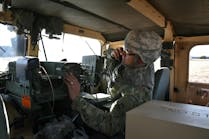Military's voracious appetite for bandwidth sounds alarm for new sensor-processing designs
Posted by Courtney Howard
LONG BEACH, Calif., 21 Jan. 2013. The market for military electronic is being driven by sensor technology, and it's time for sensor-processing systems designers to do something about it, says Ray Alderman, executive director of the VITA embedded computing trade organization.
Sensor technology is advancing rapidly, and the innovations coming off today's production lines are driving aerospace and defense electronic design, Alderman said today at the VITA Embedded Tech Trends in Long Beach, Calif.
The military's demand for streaming high-quality data is "sucking bandwidth like crazy," Alderman told conference attendees. "We've got to kill the bandwidth hog problem, particularly on unmanned aerial vehicle (UAV) applications. There's a need to move the processor to the sensor, providing both in a single package feeding back to an aggregator box, which is where VPX fits in.
| Related stories -- Unmanned, sensor-laden, and ubiquitous -- Unmanned sensor and processing payloads proliferate -- Networking, GPU technologies advance graphics, video processing. |
Alderman's call for action particularly concerns designers of radar, sonar, electronic warfare, and communications intelligence (COMINT) systems. "In the military market, many applications require double, triple, and quadruple the bandwidth they have now, such as 100G on a single pair or on a fiber," Alderman continues. "Among these applications are radar, sonar, electronic warfare, and communications intelligence."
Systems designers must concern themselves not only with communications bandwidth, but also with the power consumption of military embedded systems that getting smaller and ever-more power-sensitive, Alderman told the conference.
"Many are shifting to ARM and Android from Intel platforms," Alderman says. "They're more low power, and they don't have half the problems you have with the Intel architecture."
VITA officials are writing specifications on temperature bandwidth of optical connectors, Alderman says. "Singlemode is dead; multimode is the focus. We've got to push bandwidth; the military is demanding it."
The VITA Embedded Tech Trends conference continues through Tuesday in at the Queen Mary Hotel in Long Beach, Calif. More information is online at www.vita.com.


